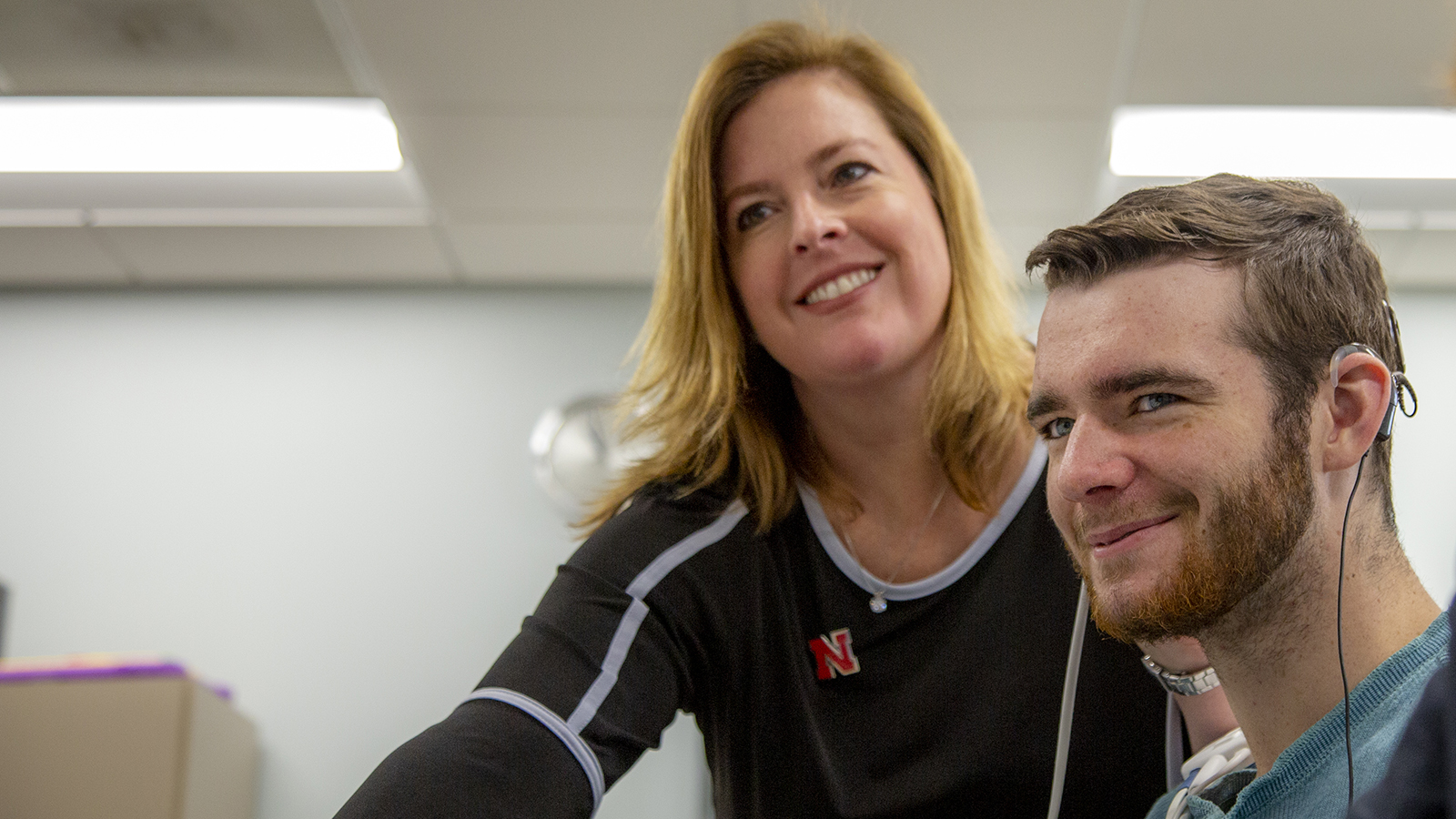
Nebraska researcher aims to improve experiences for cochlear implant users
17 Jan 2019 By Kelcey Buck
When Michelle Hughes arrived at the University of Nebraska-Lincoln in August, she brought two lines of research with her: one aiming to refine the programming of cochlear implants so patients of all abilities will benefit; and a second focused on determining how to effectively provide cochlear implant programming, speech perception testing and aural rehabilitation services via telepractice.
Hughes, an associate professor in the Department of Special Education and Communication Disorders, now has her Cochlear Implant Research Laboratory (CIRL) up and running at the Barkley Memorial Center, and is focused on continuing to find ways to better serve cochlear implant patients of all ages and in all areas of the state and beyond.
Hughes’ first research line is aimed at understanding how well neural measures in cochlear implant users predict what the individuals are actually able to hear. Her hope is that with a better understanding of the relationship between the physiological measures and behavioral outcomes, audiologists will be able to better program the cochlear implant processors, particularly in young children or individuals with developmental disabilities who may not be able to communicate what they are hearing.
“Our overall goal is to figure out how the physiological measures relate to the perceptual measures so that we can use the physiology to program processors for people who can’t give us that behavioral information that we need,” Hughes said.
While she and her lab team work to analyze data from the initial studies, Hughes continues to work on the last phase of the project, which is investigating how changing the type of stimulus might reveal more about nerve survival in cochlear implant patients.
“Right now, we don’t have a way to know if Person A or Person B has better or worse nerve survival than the other person, and how well that is going to relate to how they do with the implant,” Hughes said. “Basically, what we know is that the longer a person is deaf, the auditory nerve fibers start to die off. But there are also certain causes of deafness that can cause more damage than others.”
Hughes’ second research line relates to the feasibility of providing cochlear implant services through telepractice. The first project in her grant was to determine whether children’s cochlear implants could be programmed effectively using distance technology or video conferencing. Through two studies, she determined that the programming results were the same for both those done face-to-face and those done remotely. Now, Hughes is aiming to figure out a way to also measure speech perception through telepractice.
“When cochlear implant patients have their processor programmed, there are outcomes that need to be measured to determine how well they are doing with the implant. How well can they understand speech with the implant? We do that by administering a speech perception test. It’s a recorded list of words or sentences and the person has to listen to it and repeat back what they hear, and then they get scored on what percentage they get correct.”
Hughes explained that tracking the speech perception over time allows audiologists to notice when those scores begin to decline. This, in turn, helps the audiologist begin to determine what might be causing the loss of speech perception, whether it’s an issue with the device or processor, or a cognitive issue. Hughes noted that the challenge with administering speech perception tests through telepractice lies in creating an environment similar to what would be available at the cochlear implant audiologist’s office.
“Typically, the testing is done in a sound booth because it has to be quiet and you have to listen to the speech coming out of the speaker. Well, let’s say your patient is in rural Nebraska and there isn’t a sound booth there. We are looking at alternatives, and specifically what we’re looking at is using a direct audio input into the processor so it bypasses the microphone. So, the project is exploring what are some alternatives to be able to do speech perception testing? And if you use those alternatives, do you get the same result as you do in the typical clinical situation when they come into the clinic and you test them face-to-face?”
The third part of the telepractice grant is focused on delivering aural rehabilitation for adults. Hughes used four groups for the study – one group received therapy face-to-face, the second received therapy via telepractice, the third did not work with a therapist at all but rather completed auditory training on their own, and the fourth group, a control group, didn’t do any training at all. The goal is similar – to determine whether the group that received therapy via telepractice had the same outcomes as the group that received face-to-face therapy in order to validate the use of telepractice for such services.
Hughes knows there will be challenges for implementing the telepractice approach, but hopes her research findings proving the feasibility will pave the way for more widespread use of telepractice for cochlear implant service delivery.
After she wraps up her current studies, Hughes has her sights set on developing a new speech perception test that better represents real-life communication challenges.
“We are using typical clinical tests for our research right now, and those tests don’t represent typical challenges that people with hearing loss or cochlear implants face in daily life. For example, the testing is usually done in a sound-treated booth, but people don’t live and work in sound-treated booths.”
To learn more about Hughes’ research, visit her lab website. Hughes is also joining lecturer and audiologist Josh Sevier to host an open house showcasing both the CIRL lab and the cochlear implant services that Sevier is providing through the Barkley Speech Language and Hearing Clinic. The open house is scheduled for 4-7 p.m. Thursday, Jan. 24, on the first floor of the Barkley Memorial Center on East Campus.
Special Education and Communication Disorders